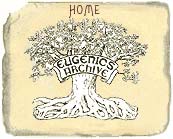
Social Origins of Eugenics
Garland E. Allen, Washington University
When many people first learn about eugenics, they wonder how intelligent people, including highly educated scientists, could have believed so many seemingly bizarre ideas. How could anyone accept the simplistic notion that complex human behaviors are determined by single genes or that mental tests designated more than three/fourths of all Russian and Polish immigrants to the U.S. as feebleminded?
To understand why eugenics gained such a following in the first three decades of the 20th century, one needs to examine the economic, social, and political context in which it flourished. Science, or what is claimed to be science, is a product of culture – like any other human activity. What seems in hindsight to be naive or absurd, must have seemed reasonable in its own era. This is especially true when scientific ideas are used to explain social problems.
American eugenics developed in the wake of turbulent economic and social problems following the Civil War. The rapid growth of American industry, coupled with the increased mechanization of agriculture, created the first major migration away from farms, and cities expanded faster than adequate housing. Wholesale exploitation of labor created militant labor union organizations. Price fluctuations bankrupted many businesses and precipitated a series of depressions, starting in 1873, and reoccurring about every decade through the early 1900s. This further fueled labor unrest. The situation was made worse by an ever-increasing tide of immigrants, mostly from southern and eastern Europe, which peaked just before, and again after, World War I.
Social Darwinism had attempted to explain away social and economic inequalities as the "survival of the fittest." However, by the turn of the century, this simplistic idea had been turned on its head. A declining birthrate among the wealthy and powerful indicated that the captains of industry were, in fact, losing the struggle for existence. The working class not only was organizing against them, but they were also outreproducing them. At the same time, traditional approaches to solving the problems of the urban poor – charity, social work, and religious institutions – were proving of little help.
Solving the new problems of industrialization demanded a change from laissez-faire to managed capitalism – toward the increased role of government and planning in the economic and social sphere. This new philosophy became known as progressivism. Embedded in progressivism was the idea of scientific management – long-range planning by university-trained experts. This new managerial class became increasingly vital to the economic process. In a country that had nurtured a reverence for invention, the use of scientific management had a special appeal. Progressive reformers had a strong faith in science as the cure-all that would herald in a new era of rational control of both nature and human society. Under these conditions, it is not surprising that the revelations of a new science of genetics gave birth to a new science of social engineering – eugenics.
Genetics appeared to explain the underlying cause of human social problems – such as pauperism, feeble-mindedness, alcoholism, rebelliousness, nomadism, criminality, and prostitution – as the inheritance of defective germ plasm. Eugenicists argued that society paid a high price by allowing the birth of defective individuals who would have to be cared for by the state. Sterilization of one defective adult could save future generations thousands of dollars.
Eugenicists and their wealthy supporters also shared a mutual antipathy for political radicalism and class struggle. They were alarmed by the increasing strength of militant labor unions and the rise of the American socialist party, especially after the success of the Bolshevik Revolution in 1917. These movements were, to some extent, correctly judged to be associated with immigrants from southern Europe, especially Italians, eastern Europeans, and Jews. These new immigrants were seen as troublemakers, and the eugenicists purported to have data showing that the problem was in their genes. The solution to the problem was simple – selective immigration restriction.
Eugenics was seen as a way to solve all of these combined problems because it placed the cause in the defective germ plasm of individuals and ethnic groups, and not in the structure of society itself. Eugenics used the cover of science to blame the victims for their own problems. Eugenicists seemed to have the weight of rigorous, quantitative, and thus scientific evidence on their side. To those with economic and social power – and imbued with the new spirit of scientific planning – eugenicists appeared to offer a rational and efficient approach of treating social problems.
In an era troubled by rapid and seemingly chaotic change, eugenics offered the prospect of a planned, gradual, and smooth transition to a more harmonious future. With its emphasis on planned breeding, eugenics provided the biological counterpart to new theories of scientific control and rational management in business. Just as a new group of professional managers was making a place for itself in American economic life, eugenicists emerged as scientists with a special expertise in the solution of perennial social problems. Eugenics provided what seemed to offer an objective, scientific approach to problems that previously had been cast almost wholly in subjective, humanitarian terms. Whereas charity and state welfare had treated only symptoms, eugenics promised to attack social problems at their roots.
